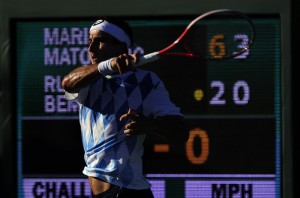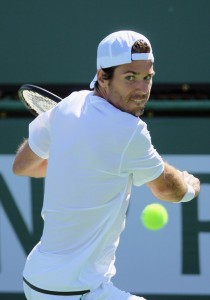To the best of my knowledge, no one is pretending that the decision not to televise the opening rounds of the Indian Wells Masters tournament is motivated by any factor besides money. Regrettably, this is bad news for any writer who covets their self-assigned role as a scourge of hypocrisy. Cynical (or realistic) decisions arrived at with both eyes fixated on revenue can only be attacked for what they are. What they are is cynical (or realistic) and that’s that; to go on about it is to inveigh against a system no one ever believed was fair in the first place.  For the writer who is merely a scrubbing-brush of idiocy . . . well, he just has to suck it up and wait, although while he does there are still points worth making.
For the writer who is merely a scrubbing-brush of idiocy . . . well, he just has to suck it up and wait, although while he does there are still points worth making.
He might point out, for example, that the dearth of early-round coverage hardly helps the lower ranked players, whose already anemic aspirations might be starved by a lack of exposure. What Indian Wells really does is reinforce the two-tier system that seeding originally created, and that the expanded seeding arrangement later augmented. Seeds already gain a putative advantage through the fact that they don’t have to play each other in the early rounds (which is true for every tournament). Indian Wells, with its absurd and extravagant allocation of byes in the first round, ensures than that the seeds won’t have to play anyone else, either. The television schedule then makes it clear for all the non-seeds who do have to play that their necessary toils do not merit a wider audience. Add this to the lingering discontent over prize money and the calendar, and we have an Occupy movement waiting to happen, although ‘movement’ implies rather greater mobility than most Occupations achieve.
The argument can be made – indeed, it has been made, too often – that such a system only inspires the have-nots to greater toils. The loot enjoyed by the top players acts as an incentive to the journeymen. They just need to get better. But the fact that this argument is mostly heard from the haves, and most vociferously from the self-made ones, should be the clue that there’s something wrong with it. What’s wrong with it is that not everyone can be a top 16 or 32 player. If every man outside the top fifty improved by a thousand per cent, the number of people inside the top fifty wouldn’t change, even as the personnel did. If we are to have a system that ranks players – and no one is advocating against that – then there should be better mechanisms in place to assist and sustain those players ranked beyond the top 32, whoever they are, and whichever direction they’re headed in.
The most pressing issue is of course prize money, which I’m not going in to right now. It was already thrashed about at length in Melbourne in January, and will continue to be sporadically thrashed as the season wears on.  For now I’ll just point out that the Masters 1000 events, as the ATP’s flagship tournaments, are the ideal place to grant the lower-ranked guys a taste of the big time, rather than force them to play a glorified qualifying round in a remote, non-televised paddock. If the top guys don’t have to play seven rounds to win, then why should anyone else, assuming they’ve earned direct entry?
For now I’ll just point out that the Masters 1000 events, as the ATP’s flagship tournaments, are the ideal place to grant the lower-ranked guys a taste of the big time, rather than force them to play a glorified qualifying round in a remote, non-televised paddock. If the top guys don’t have to play seven rounds to win, then why should anyone else, assuming they’ve earned direct entry?
We might point out that more people turned up to watch Roger Federer’s practice session than saw Marinko Matosevic beat Ruben Bemelmans, and that the broadcasters are only showing viewers what they want to see. There is a point here, but it’s disingenuous to suggest that the purpose of media is merely to reflect public desire – Rupert Murdoch’s classic, fatuous justification for tabloid drivel – because it is misleading to imply that what is shown on television doesn’t itself shape what people want to see. Maybe people don’t want to see the early rounds of a Masters event, but if you don’t ever show it, you merely guarantee that they never will.
Furthermore, amongst the legion unwashed and unwatched journeymen, there were plenty of men playing yesterday that would generate ample interest in their respective markets, if only there was a camera running: Haas, Tomic, Davydenko, Llodra, Gulbis. Even those fans who confine their affection to the top players must see this point. Think of how many formative matches of the young Federer were never televised, because he was toiling away in the back lot. Wouldn’t you like to see them now? If nothing else, it’s something to think on, while we consider that Dimitrov, Harrison and Kudla all played well yesterday in posting wins. Surely I am not alone in wishing we could have seen it.

3 Responses to The Unwatchables (Part One)